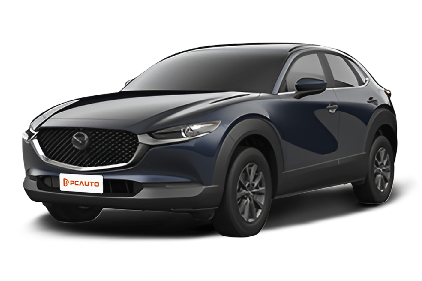Q
How many colors does the Mazda CX 30 have?
Common colors of the Mazda CX 30 include Soul Red, Crystal Blue, Polar Grey, Steel Grey, and Pearl White. The supply of specific colors may vary depending on the sales region and market demand.
Special Disclaimer: This content is published by users and does not represent the views or position of PCauto.
Related Q&A
Q
How to replace the rear windshield wiper of Mazda CX-30?
To replace the rear wiper blade of Mazda CX-30, first lift the wiper arm to an upright position. Locate the release tab at the connection point between the wiper blade and arm, then press or twist it to release. Remove the old wiper blade and align the new blade's locking tab with the arm's slot, inserting it securely until you hear a click. Finally, gently lower the wiper arm back into place. During this process, handle all components carefully to avoid damaging any vehicle parts.
Q
What type gasoline does Mazda CX 30 require?
The Mazda CX-30 typically requires unleaded gasoline, with 95 RON the most commonly recommended grade. However, the adoption of specific fuel type based on the vehicle's owner's manual an local gasoline station availability. In general, 95 RON unleaded gasoline adequately meets the vehicle's operational requirements, ensuring optimal engine performance and fuel efficiency.
Q
How to turn off the auto parking brake of Mazda CX-30?
To turn off the auto parking brake of Mazda CX-30, you can generally find the relevant option in the control panel or settings menu of the vehicle. The specific steps may vary depending on the configuration of the model. Typically, you can find buttons or settings related to the brake system in the control area near the driver's seat, and then operate according to the prompts on the screen. Please note that before making any operations, make sure that your vehicle is stationary and in a safe condition.
Q
How to activate the All-Wheel Drive (i-Activ AWD) system of Mazda CX-30?
The Mazda CX-30's all-wheel drive system (i-Activ AWD) operates fully automatically without requiring manual activation or switching - drivers don't need to perform any additional operations. The system continuously monitors road conditions, tire traction, and power distribution needs through onboard computers, automatically adjusting torque split between front and rear wheels (typically front-biased, but capable of sending up to 50% power rearward) during acceleration, cornering, or on slippery surfaces. To ensure proper functioning, simply check for the AWD indicator on the instrument cluster - if the warning light illuminates abnormally, professional inspection may be needed. Mazda's i-Activ AWD is renowned for its fuel efficiency, consuming less than traditional full-time AWD systems while being particularly suitable for Malaysia's frequent wet roads and mild off-road conditions. However, it's important to note this isn't a hardcore off-road system, and extreme terrain still requires cautious driving.
Q
How to adjust the seats of Mazda CX 30?
The seat adjustment method for the Mazda CX 30 is as follows: First locate the seat adjustment button, usually located on the side of the seat. Forward and backward adjustment can be achieved by pushing the button forward or backward to obtain comfortable leg space. The height of seat can be adjusted by switching the corresponding button up and down to meet the vision requirements of different drivers. Backrest angle adjustment is achieved by rotating or switching the relevant button, finding the sitting posture that suits you. If there is lumbar support adjustment, it can also be adjusted as needed to enhance driving comfort.
Q
What's the price of Mazda CX-30?
According to reference information, the price of the Mazda CX-30 in Malaysia varies by specific models. The 1.5L Skyactiv-G naturally aspirated version starts at approximately RM143,000, while the higher-end 2.0L Skyactiv-G variant approaches RM160,000 (actual prices may fluctuate depending on dealer promotions or optional packages). Positioned as a compact crossover SUV, the CX-30 emphasizes excellent interior quality and handling performance, equipped with LED headlights, leather seats, and advanced safety technologies like the i-Activsense driver assistance system. Compared to Japanese competitors such as the Honda HR-V (from around RM130,000) and Toyota Corolla Cross (from approximately RM130,000), the CX-30 attracts a specific consumer group with its more sophisticated interior craftsmanship and brand appeal. It is advised to contact authorized Mazda Malaysia (Bermaz Motor) dealers directly to confirm the latest price and promotional activities, as well as to experience its distinctive Skyactiv chassis tuning through a test drive.
Q
Which model of Mazda CX 30 is equipped with a sunroof?
Some high-end versions of the Mazda CX 30 are equipped with sunroofs. However, specific model comes with a sunroof can vary depending on the batch and configuration. Generally, higher level configurations are more likely to have a sunroof.
Q
How to set the memory seats in Mazda CX-30?
To set up the memory seat function in Mazda CX-30, first ensure the vehicle is started and shifted into Park (P). Adjust the seat to your preferred driving position, including the forward/backward distance, backrest angle, and headrest height. Then press and hold the "SET" button on the side of the seat for about 3 to 5 seconds until you hear a confirmation beep, immediately followed by pressing either the "1" or "2" button to save the current settings. To recall your saved position later, simply press the corresponding number button, and the seat will automatically adjust to the memorized position.
If the setup fails, try shifting back into Park (P) and ensuring the electronic parking brake is pulled up,or after holding the "SET" button, press the number button before releasing it. Note that procedure may vary slightly between different models, so it's recommended to consult the vehicle manual or check with an authorized Mazda dealer for confirmation.
The memory seat function not only makes it convenient for family members to switch driving positions but can also be linked to the smart key for automatic seat adjustment, further enhancing convenience. Higher-end models may also include synchronized memory settings for the steering wheel angle and side mirrors. In Malaysia's hot and humid climate, regularly cleaning the seat rails and electrical contacts can prevent malfunctions caused by dust buildup, with maintenance costs typically ranging between RM50 and RM100.
Q
How to open the engine hood of Mazda CX 30?
To open the engine hood of Mazda CX-30, first ensure the vehicle is parked securely with the parking brake pulled up. Find the hood release lever on the driver's side lower dashboard (typically positioned between the door and instrument panel), then firmly pull upward. This will pop the hood open slightly, creating a 3-5 cm gap. Move to the front of the vehicle, reach into this gap to find the safety latch, and while pushing it sideways (left or right), simultaneously lift the hood. Finally, secure the hood in place using the support rod.
Note that Mazda's engine hood support rods are usually located at the center-left of the hood interior - after lifting, firmly insert the rod's tip into its designated slot for safety. When closing, gently lower the hood from about 30 cm height to allow automatic latching.
Regularly opening the engine hood for inspections of fluids (engine oil, coolant, etc.) is crucial for vehicle maintenance. Particularly in Malaysia's hot and rainy climate, we recommend performing basic checks every 3 months or 5,000 km. If you notice fluid levels dropping below minimum marks or any leakage signs, you should visit an authorized service center promptly. Mazda's genuine coolant and engine oil are specially formulated for local conditions, ensuring optimal engine cooling and lubrication performance.
Q
What are the differences between Mazda CX-5 and CX-30?
The Mazda CX-5 and CX-30 differ in several respects. In terms of size, the CX-5 is larger than the CX-30, offering more spacious interior. In terms of power, although both have efficient engine configurations, specific performance varies by model. In terms of exterior design, the CX-5 appears more robust and steady, while the CX-30 is more stylish and sporty. For interior decoration, the CX-5 emphasizes comfort and luxury, while CX-30 highlights refinement and technology. As for configurations, the CX-5 focuses on comfort and safety features, while CX-30 attracts consumers with practical and intelligent configurations. Overall, the two are positioned differently to meet different consumer needs.
Latest Q&A
Q
What is the PCD Size of Honda Civic Type R?
The PCD (Pitch Circle Diameter) of the Honda Civic Type R is 5x120. This means its wheels have 5 bolt holes, evenly spaced around a circle with a diameter of 120 millimeters. This specification is similar to many high - performance vehicles and is suitable for pairing with wide wheels and high - performance tires to enhance handling.
For Malaysian car owners, understanding the PCD size is very important. When replacing wheels or upgrading the braking system, it's essential to ensure that the PCD of the new components matches the original factory specifications. Otherwise, adapter flanges may be required, which can affect safety and may not comply with local regulations.
In addition, the center bore diameter of the Civic Type R's wheels is 64.1 millimeters, and the offset (ET) usually ranges from 45 to 55. These figures also influence the selection and installation of wheels.
If you're planning to modify your vehicle, it's advisable to choose certified wheel brands and consult professional technicians to ensure compliance with the requirements of JKR and JPJ while maintaining the vehicle's original performance and safety standards.
Q
What is the Gearbox Type of Honda Civic Type R?
The Honda Civic Type R is equipped with a 6-speed manual transmission. This transmission is specifically tuned for high-performance driving, featuring short-throw shifting and precise clutch feedback. It can fully unleash the power of its 2.0-liter VTEC turbocharged engine, making it an ideal choice for Malaysian drivers who seek driving pleasure.
A manual transmission allows drivers to be more directly involved in power transfer. Moreover, techniques like rev-matching during downshifting can enhance cornering performance. The Type R's transmission comes with a rev-matching function, which reduces jerking during gear changes and is more newbie-friendly.
It's worth noting that the manual transmission still has a loyal following in Malaysia's driving culture, especially among performance car enthusiasts. This is because it offers a purer driving experience. Additionally, the Type R's transmission is designed with daily durability in mind. For example, the synchronizers and gear materials are strengthened to suit the diverse local road conditions.
When compared with other hot hatches in the same class, the Type R's manual setup emphasizes the sense of driving engagement rather than simply chasing shift speed. This distinctive positioning makes it stand out in the Malaysian market.
Q
What Engine is Used in Honda Civic Type R?
The Honda Civic Type R is powered by a 2.0-liter turbocharged four-cylinder gasoline engine with the code K20C1. This engine is well - known for its high performance and reliability. It can deliver a maximum power of 320 horsepower and a peak torque of 400 Nm. Paired with a 6 - speed manual transmission, it offers an extremely fun - to - drive handling experience.
This engine features VTEC (Variable Valve Timing and Lift Electronic Control) technology and is combined with a turbocharging system. This ensures strong torque output at low revs and powerful performance at high revs, making it highly suitable for Malaysia's winding roads and urban driving conditions.
Notably, this engine has undergone special tuning to meet the dual requirements of the Type R model for both track and daily driving, while still maintaining Honda's consistent fuel efficiency.
For Malaysian car enthusiasts, the Civic Type R is not just a high - performance front - wheel - drive hot hatch. It is also an outstanding example of Honda's engineering. Its engine design takes into account both durability and the thrill of driving, making it a perfect choice for local car owners who love to drive.
Q
How Much CC Does Honda Civic Type R Discharge?
As a high-performance hatchback beloved by Malaysian car enthusiasts, the Honda Civic Type R is powered by a 2.0-liter four-cylinder turbocharged gasoline engine with a specific displacement of 1996cc (commonly referred to as 2000cc or 2.0L). This engine can churn out over 300 horsepower in both the FK8 and FL5 generations. Paired with a 6-speed manual transmission, it offers drivers an extremely enjoyable driving experience. For the Malaysian market, the engine displacement of the Civic Type R falls within the range familiar to local consumers. It can not only meet the needs of daily driving but also showcase its high-performance potential on track days.
It's worth noting that although the displacement remains the same, there are upgrades in turbocharging technology, fuel injection systems, and engine tuning for different generations of the Type R. For example, the FL5 version has optimized turbo response and cooling efficiency, which is why it can produce higher horsepower while maintaining the same displacement.
In addition, when Malaysian car enthusiasts choose performance cars, besides paying attention to displacement, they also comprehensively consider the vehicle's suspension tuning, aerodynamic design, and electronic assistance systems. The Civic Type R also performs excellently in these aspects. In particular, its front-wheel-drive chassis tuning is a benchmark in its class and doesn't lose out even when competing with rear-wheel-drive models with larger displacements.
Q
What is the Reslae Value of Honda Civic Type R?
As a high-performance front-wheel-drive sports car, the Honda Civic Type R has shown excellent resale value in the Malaysian used car market. Especially for models in good condition with low mileage, the residual value rate usually remains around 60% to 70% after three years. This is due to the reputation of the Type R series in the sports car field, the scarcity of limited supply, and the recognition of the Honda brand in the local market.
The key factors affecting its second-hand price include the vehicle's maintenance record (it is recommended to keep complete 4S shop repair receipts), whether it has been modified (the original factory state is more preferred), and the body color (classic color schemes such as Championship White hold their value better). At the same time, it should be noted that the FK2 generation before 2017 has less inventory in the right-hand drive market, so it actually has more collection premium space than the subsequent FK8 generation.
For potential buyers, it is recommended to purchase through the certified used car channel on the official website of Honda Malaysia or professional sports car dealers. These channels usually provide additional warranty services. Owners who love track driving need to pay special attention to checking the heat dissipation system and clutch wear. Because the high-rev turbo engine of the Type R places a large load on the cooling system after intense driving, these details will directly affect the valuation when reselling.
View MoreRelated News

Revealed: Mazda CX-30's Premium Quality & Surprising Value
LienApr 23, 2025

Mazda Earns the Most IIHS TOP SAFETY PICK+ Awards in 2025
Kevin WongMar 17, 2025

The third-generation Mazda CX-5 debuts in Europe, equipped with the largest central control screen in Mazda's history
MichaelJul 11, 2025

Rotary Reborn: Iconic SP Heads for Production
WilliamJun 26, 2025

From Design to Performance: Unveiling the Highlights of the Mazda CX-8
MichaelMay 14, 2025
View More


















Pros
Cons